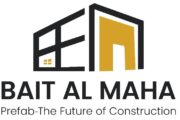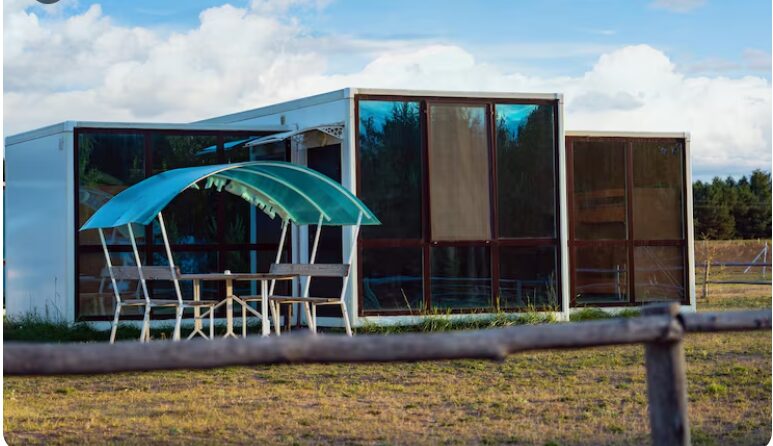Container site office represents a revolutionary approach to creating flexible, durable, and sustainable workspaces in the UAE, a country known for its rapid development, extreme environmental conditions, and commitment to innovation. These structures, often constructed from repurposed shipping containers or purpose-built modular units, are designed to serve as temporary or semi-permanent offices for a wide range of industries, including construction, logistics, oil and gas, event management, and small businesses. In the UAE, where dynamic economic growth, ambitious infrastructure projects, and a focus on sustainability drive business operations, container site office have emerged as a transformative solution for creating efficient, adaptable workspaces in diverse settings from bustling urban construction sites in Dubai to remote desert locations in Abu Dhabi.
The concept of a container site office is rooted in the idea of modular construction, where standardized units are prefabricated off-site and assembled quickly at the desired location. These offices are typically made from robust materials like steel or aluminum, ensuring durability in the UAE’s harsh climate, which includes temperatures exceeding 50°C, sandstorms, and high humidity in coastal areas. Their modular design allows for easy transportation, rapid deployment, and extensive customization, making them ideal for projects with tight timelines or changing locations. Unlike traditional brick-and-mortar offices, which require months or years to construct, container offices can be operational within hours or days, offering unparalleled efficiency.
Key Features of Container Site Office:
- Portability: Easily transported via trucks or cranes, ideal for dynamic project locations.
- Durability: Built to withstand extreme weather, including heat, sandstorms, and humidity.
- Sustainability: Made from recycled or recyclable materials, reducing environmental impact.
- Customization: Flexible designs with options for interiors, climate control, and technology.
- Rapid Deployment: Installed in hours or days, compared to months for traditional offices.
Why the UAE?:
- Economic Growth: The UAE’s infrastructure projects demand flexible workspaces.
- Logistics Hub: Ports and transport networks support efficient container delivery.
- Sustainability Goals: Eco-friendly designs align with national environmental priorities.
- Climate Challenges: Robust construction ensures functionality in extreme conditions.
This article will guide you through the myriad benefits, technical details, and practical considerations of container site office, offering a comprehensive resource for decision-makers in the UAE.
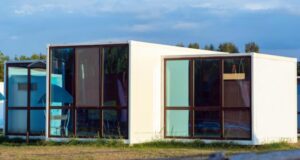
Benefits of Container Site Office
Container site office offers a multitude of benefits that make them a compelling choice for businesses in the UAE, particularly in industries requiring flexibility, durability, and sustainability. These advantages address the unique challenges of operating in the UAE’s fast-paced and environmentally demanding landscape, offering practical solutions for various use cases.
Cost-Effectiveness Compared to Traditional Construction
Traditional office construction in the UAE involves significant investments in materials, labor, land, and permitting, often requiring months of planning and execution. Container site office, by contrast, are prefabricated or repurposed from existing shipping containers, streamlining the production process and reducing material costs. The off-site manufacturing minimizes labor-intensive on-site work, and the modular nature eliminates the need for extensive foundations or permanent structures. For businesses with temporary or short-term needs, such as construction projects or events, container offices offer a cost-efficient alternative to leasing or building permanent offices, allowing resources to be allocated to core operations.
Portability and Relocation Flexibility
One of the standout features of container site office is their portability, which is particularly valuable in the UAE’s dynamic project environments. These units can be transported using standard trucks, cranes, or flatbed vehicles, enabling businesses to move offices between sites as projects evolve. For example, a construction company might use a container office at a Dubai skyscraper site and later relocate it to a new development in Abu Dhabi. This flexibility reduces the need for multiple office setups, saving time and resources. The modular design also allows for stacking or combining units to create larger complexes, which can be disassembled and moved as needed.
Durability in Harsh Environments
The UAE’s climate, characterized by extreme heat, sandstorms, and coastal humidity, poses significant challenges for traditional buildings. Container site office are engineered for resilience, typically constructed from high-strength materials like mild steel or galvanized iron. These materials are treated with weather-resistant coatings to prevent corrosion and withstand UV radiation, ensuring longevity in the UAE’s conditions. The structural design adheres to international standards, such as ISO or DNV-GL, ensuring stability against wind, seismic activity, and other environmental stresses. This durability makes container offices ideal for remote locations, such as desert oil fields or coastal logistics hubs, where traditional structures may require frequent maintenance.
Eco-Friendly Design
Sustainability is a core advantage of container site offices, aligning with the UAE’s environmental goals. Many units are made from repurposed shipping containers, giving new life to materials that might otherwise be discarded. The prefabrication process minimizes construction waste, as components are manufactured with precision in controlled environments. Additionally, container offices can be equipped with energy-efficient features, such as thermal insulation, LED lighting, and solar panels, reducing energy consumption. These eco-friendly attributes support the UAE’s Vision 2021 and Net Zero 2050 initiatives, which prioritize sustainable development and reduced carbon emissions.
Rapid Deployment and Time Efficiency
In the UAE, where project timelines are often compressed to meet ambitious development goals, the rapid deployment of container site office is a significant advantage. Unlike traditional construction, which can take months or years, container offices can be installed and operational within hours or days. The prefabricated units are delivered ready for assembly, requiring only basic site preparation and utility connections. This speed is critical for industries like construction, where immediate on-site presence is needed, or events, where temporary offices must be set up and dismantled quickly.
Customization for Diverse Needs
Container site office offer extensive customization options, allowing businesses to tailor the workspace to their specific requirements. Interiors can be configured with partitions for private offices, open-plan layouts for collaborative work, or specialized areas for storage or meetings. Features like air conditioning, ventilation, and soundproofing ensure comfort in the UAE’s climate, while options for windows, doors, and exterior finishes enhance aesthetics and functionality. This versatility makes container offices suitable for a wide range of applications, from minimalist construction site hubs to sophisticated event management offices.
Scalability and Modularity
The modular design of container offices allows for scalability, enabling businesses to expand or reconfigure their workspace as needed. Multiple units can be connected horizontally or stacked vertically to create larger complexes, accommodating growing teams or evolving project demands. This scalability is particularly valuable in the UAE, where projects often scale rapidly, such as during major infrastructure developments or international expos.
Low Maintenance Requirements
Container offices require minimal maintenance compared to traditional buildings, thanks to their durable materials and simple design. Regular cleaning, rust prevention, and HVAC servicing are typically sufficient to maintain functionality, reducing long-term operational costs. This low maintenance is ideal for businesses operating in remote or high-traffic areas where frequent upkeep may be challenging.
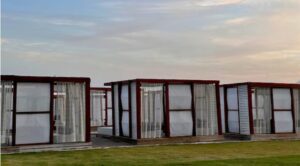
Features and Technical Specifications
Container site office are engineered with a range of features and technical specifications to ensure functionality, durability, and comfort in the UAE’s challenging environments. Understanding these specifications is essential for assessing their suitability for specific projects and ensuring they meet operational needs.
Size and Dimensions
Container site office are available in standardized sizes to accommodate various team sizes and purposes:
- 10ft Containers: Approximately 7.2 square meters, ideal for small teams, site supervisors, or single-purpose offices (e.g., equipment monitoring stations). These compact units are highly portable and suitable for constrained spaces.
- 20ft Containers: Around 15 square meters, offering space for medium-sized teams or multi-purpose workspaces, such as project management offices with desks and storage.
- 40ft Containers: Approximately 30 square meters, capable of housing larger teams, meeting rooms, or extensive equipment. These are common in large-scale construction or logistics operations.
- High-Cube Containers: With a height of 9.6ft (compared to 8.6ft for standard units), these provide additional vertical space for enhanced comfort, ventilation, or specialized installations.
- Custom Sizes: Modular designs allow for combining or modifying units to create bespoke sizes, such as 60ft complexes or multi-level setups.
Materials and Construction
The structural integrity of container offices relies on high-quality materials designed for durability:
- Mild Steel: A cost-effective, high-strength material used for the primary framework, capable of withstanding heavy loads and environmental stress. Its robustness ensures long-term stability in the UAE’s climate.
- Galvanized Iron: Coated with zinc to prevent corrosion, galvanized iron is ideal for coastal areas where humidity and salt exposure are concerns. It extends the lifespan of the office in harsh conditions.
- Aluminum: Lightweight and corrosion-resistant, aluminum is used for components like window frames, doors, or roofing panels, reducing overall weight for easier transport.
- Sandwich Panels: Walls, floors, and roofs often use sandwich panels, which combine metal exteriors with insulating cores (e.g., polyurethane, rockwool, or polystyrene) for thermal and acoustic performance.
- Weather-Resistant Coatings: Applied to exterior surfaces, these coatings protect against UV radiation, extreme heat, sand abrasion, and moisture, ensuring the office remains intact in the UAE’s desert and coastal environments.
Insulation and Climate Control
The UAE’s extreme climate demands robust insulation and climate control systems:
- Thermal Insulation: Polyurethane foam or rockwool panels reduce heat transfer, maintaining interior temperatures 20–30°C cooler than external conditions. This is critical for comfort during summer months when temperatures can exceed 50°C.
- Soundproofing: Insulation materials and sealed designs achieve noise reduction levels below 30 decibels, ideal for noisy environments like construction sites or busy urban areas.
- Air Conditioning: High-efficiency split or ducted AC units are integrated to ensure a comfortable working environment. Options for variable refrigerant flow (VRF) systems provide precise temperature control.
- Ventilation: Mechanical ventilation systems, such as exhaust fans or heat recovery ventilators, ensure adequate airflow and prevent humidity buildup in coastal regions. Strategically placed windows can enhance natural ventilation.
- Dehumidifiers: In humid areas like Dubai or Sharjah, dehumidifiers prevent moisture damage to electronics and furnishings.
Structural Standards
Container offices adhere to international and local standards to ensure safety and reliability:
- ISO Standards: Ensure compatibility with global shipping and structural requirements, facilitating transport and quality assurance.
- DNV-GL Certification: Verifies durability for high-risk environments, such as offshore oil platforms or desert sites.
- Seismic and Anti-Cyclone Design: Incorporates reinforcements like cross-bracing and heavy-duty welds to withstand earthquakes or high winds, which are occasional concerns in remote UAE regions.
- Fire Resistance: Fireproof insulation and materials comply with UAE fire safety codes, reducing risks in high-temperature environments.
Customization Features
The modular design allows for extensive customization to meet diverse needs:
- Interior Layouts: Options include open-plan spaces for collaborative work, private offices for supervisors, meeting rooms with conference tables, or storage areas for equipment and documents.
- Windows and Doors: Shatterproof glass windows provide natural light and visibility, while reinforced steel doors with heavy-duty locks enhance security. Sliding or double doors improve accessibility.
- Electrical Systems: Power sockets, LED or fluorescent lighting, and data cabling support modern office needs. Options for solar-powered systems reduce reliance on grid electricity.
- Plumbing: Self-contained units can include restrooms, sinks, or water storage tanks, ideal for remote locations without access to utilities.
- Furnishings: Built-in desks, cabinets, shelving, or ergonomic chairs can be tailored to the office’s purpose, from administrative hubs to creative studios.
- Exterior Finishes: Weather-resistant paints, cladding (e.g., wood, aluminum, or composite panels), or decorative wraps enhance aesthetics, aligning with the UAE’s modern architectural trends.
Accessibility and Safety
- Accessibility: Ramps, wide doorways, and non-slip flooring ensure compliance with UAE accessibility standards for all users.
- Safety Features: Fire extinguishers, smoke detectors, and clearly marked emergency exits are standard. Anti-slip coatings on floors prevent accidents in high-traffic areas.
Technological Integration
Modern container offices can incorporate advanced technologies:
- Smart Systems: IoT-enabled climate control, lighting, and security systems for efficiency and remote management.
- Data Connectivity: High-speed Wi-Fi, Ethernet ports, or satellite communication for remote sites.
- Energy Monitoring: Smart meters track power usage, optimizing energy efficiency.
These specifications ensure container offices are versatile, durable, and adaptable to the UAE’s unique environmental and operational challenges.
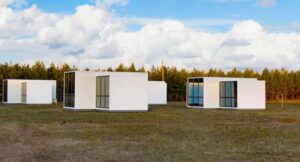
Applications in UAE Industries
Container site office are highly versatile, serving a wide range of industries in the UAE with tailored applications. Their adaptability makes them invaluable for businesses operating in diverse environments, from urban centers to remote deserts.
Construction Industry
The UAE’s construction sector, driven by mega-projects like smart cities, skyscrapers, and infrastructure developments, relies heavily on container site office. These units provide on-site workspaces for:
- Project Management: Offices for supervisors, engineers, and architects to coordinate activities, review blueprints, and meet with contractors.
- Administrative Hubs: Spaces for payroll, scheduling, and documentation, equipped with desks, computers, and storage.
- Storage and Safety: Areas for securing tools, equipment, or safety gear, with lockable doors and shelving.
Their portability allows construction companies to move offices between sites, such as from a Dubai residential project to an Abu Dhabi infrastructure development. The durable construction withstands dust, vibrations from heavy machinery, and extreme heat, while customizations like large windows provide visibility of site activities.
Oil and Gas Sector
The oil and gas industry, a cornerstone of the UAE’s economy, operates in remote desert locations or offshore platforms where traditional offices are impractical. Container site office serve as:
- Supervisory Hubs: Workspaces for monitoring drilling operations, housing control panels, and communication systems.
- Crew Facilities: Rest areas, break rooms, or medical stations for workers on long shifts.
- Data Centers: Offices with secure servers for real-time data analysis, critical for operational efficiency.
Their self-contained design, with options for restrooms, water storage, and robust insulation, ensures functionality in isolated environments. The ability to relocate offices as drilling sites shift enhances operational flexibility.
Logistics and Transportation
As a global logistics hub, the UAE relies on efficient administrative operations near ports, warehouses, and distribution centers. Container offices support:
- Port Operations: Administrative hubs for customs officials, logistics coordinators, or shipping managers near ports like Jebel Ali.
- Warehouse Management: On-site offices for inventory tracking, scheduling, and quality control.
- Temporary Hubs: Workspaces for short-term logistics projects, such as seasonal trade surges.
Their proximity to operational areas ensures real-time oversight, while modular designs allow expansion as logistics needs grow.
Events and Exhibitions
The UAE’s vibrant events industry, including expos, festivals, and trade shows, benefits from container offices for:
- Event Coordination: Offices for ticketing, vendor management, and logistics planning, equipped with Wi-Fi and workstations.
- Staff Facilities: Break areas or storage for event materials, with lockable compartments for security.
- Branding Opportunities: Exterior wraps or decorative finishes align with event themes, enhancing visual appeal.
Their rapid deployment and dismantling make them ideal for temporary events, such as Dubai’s annual expos or outdoor festivals.
Small and Medium Enterprises (SMEs)
SMEs, particularly startups in the UAE’s free zones, use container offices as cost-effective workspaces:
- Startup Hubs: Compact offices for small teams, with modern furnishings and high-speed internet.
- Creative Studios: Spaces for design, tech, or media companies, customized with open layouts and aesthetic finishes.
- Temporary Bases: Flexible solutions for businesses testing new markets or locations without long-term leases.
Their affordability and customization options make them ideal for businesses with limited resources but high growth potential.
Education and Community Projects
Container offices are increasingly used for educational or community initiatives:
- Temporary Classrooms: Spaces for training programs or workshops in remote areas.
- Community Centers: Hubs for local organizations or disaster relief operations, equipped with meeting rooms and utilities.
- Mobile Libraries: Compact units for educational outreach in rural communities.
Their portability and durability make them suitable for temporary or semi-permanent community projects.
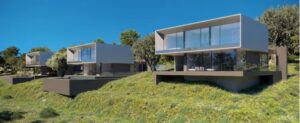
UAE Market Trends and Insights
The demand for container site office in the UAE is shaped by broader economic, environmental, and technological trends, reflecting the country’s unique position as a global hub for innovation and development.
Growth in Modular Construction
The UAE’s construction sector is increasingly adopting modular and prefabricated solutions to meet the demands of rapid urbanization and infrastructure development. Container site office fit seamlessly into this trend, offering prebuilt workspaces that reduce project timelines and environmental impact. The country’s focus on smart cities, such as Dubai’s Sustainable City, drives the need for flexible, scalable offices that can be deployed quickly and adapted to changing project scopes.
Sustainability as a Priority
The UAE’s commitment to sustainability, as outlined in Vision 2021, the UAE Net Zero 2050 strategy, and the Dubai Clean Energy Strategy 2050, emphasizes eco-friendly construction practices. Container offices align with these goals by:
- Repurposing Materials: Using recycled shipping containers reduces the demand for new resources.
- Minimizing Waste: Prefabrication produces less debris than traditional construction.
- Energy Efficiency: Features like insulation, LED lighting, and solar panels reduce energy consumption.
This focus on sustainability appeals to businesses aiming to meet environmental regulations and corporate social responsibility objectives.
Logistics and Supply Chain Advantages
The UAE’s role as a global logistics hub, with ports like Jebel Ali and advanced transport networks, supports the supply chain for container offices. The availability of shipping containers, coupled with efficient logistics infrastructure, ensures that these units can be sourced, customized, and delivered quickly to urban or remote sites. The country’s investment in technologies like blockchain and autonomous vehicles further streamlines container transport and tracking.
Urbanization vs. Remote Operations
The UAE’s blend of urban development and remote industrial operations creates diverse use cases for container offices. In urban areas, they serve as temporary workspaces during construction, renovation, or events. In remote regions, such as desert oil fields or rural infrastructure sites, they provide durable, self-contained offices that support long-term operations without the need for permanent infrastructure.
Technological Advancements
The adoption of smart technologies in the UAE’s construction and real estate sectors is influencing container office design. Features like IoT-enabled climate control, smart lighting, and remote monitoring are becoming standard, enhancing efficiency and user comfort. The UAE’s investment in 5G networks and smart city initiatives supports the integration of these technologies, positioning container offices as forward-thinking solutions.
Cultural and Economic Drivers
The UAE’s business culture, which values efficiency, innovation, and modernity, drives demand for container offices. Their sleek, customizable designs align with the country’s architectural aesthetic, while their rapid deployment supports the fast-paced nature of UAE projects. Additionally, the emphasis on hosting global events, such as expos and summits, creates a need for temporary, high-quality workspaces.
Customization and Installation Process

The customization and installation of container site office are critical processes that determine their functionality, comfort, and suitability for specific projects in the UAE. These processes involve detailed planning, design, and execution to meet operational and environmental requirements.
Customization Options
Container offices offer extensive customization to cater to diverse needs:
- Interior Layouts: Options include open-plan spaces for collaborative work, private offices with partitions, meeting rooms with conference tables, or storage areas for equipment. Flexible designs allow for reconfiguration as needs change.
- Windows and Doors: Shatterproof glass windows maximize natural light and provide visibility, ideal for construction sites. Reinforced steel doors with heavy-duty locks or smart access systems enhance security. Sliding or double doors improve accessibility for high-traffic offices.
- Climate Control: High-efficiency air conditioning (split or ducted systems), heaters, and ventilation fans ensure comfort in the UAE’s extreme climate. Smart thermostats adjust settings based on occupancy or weather, optimizing energy use.
- Electrical Systems: Power sockets, LED lighting, and data cabling support modern office needs. Options for solar panels or backup generators ensure reliability in remote areas.
- Plumbing: Self-contained units can include restrooms, sinks, or water storage tanks, ideal for isolated sites without utility access. Water-saving fixtures align with sustainability goals.
- Furnishings: Built-in desks, ergonomic chairs, cabinets, and shelving can be tailored to the office’s purpose, from administrative hubs to creative studios.
- Exterior Finishes: Weather-resistant paints, aluminum or wood cladding, or decorative wraps enhance aesthetics, aligning with the UAE’s modern architectural trends. Green roofs with vegetation or solar panels add sustainability and visual appeal.
- Technology Integration: IoT-enabled systems for climate control, lighting, and security, plus high-speed Wi-Fi or satellite connectivity for remote sites.
Installation Process
Installing a container office in the UAE involves several steps, tailored to the country’s unique conditions:
- Site Assessment: Evaluate the location for ground stability, accessibility, and utility availability. In desert areas, assess sandy or rocky terrain; in urban areas, ensure compliance with zoning regulations.
- Site Preparation: Level the ground and install a foundation, such as concrete slabs, piers, or gravel beds, to ensure stability. Drainage systems prevent water accumulation during rare rainfall.
- Delivery: Transport the container via tilt tray trucks, hiab cranes, or flatbed vehicles. Flat-pack designs reduce shipping volume for remote or international transport.
- Assembly: For modular or flat-pack units, assemble walls, roofs, and interiors on-site. Prefabricated units require only placement and anchoring.
- Utility Connections: Install electrical, plumbing, and HVAC systems, ensuring compliance with UAE safety standards. Solar or generator setups may be used for off-grid sites.
- Final Inspection: Verify structural integrity, safety features (e.g., fire exits, smoke detectors), and regulatory compliance before use.
Challenges in the UAE
- Climate: Extreme heat (up to 50°C) and sandstorms require robust insulation and sealed designs to maintain comfort and prevent dust ingress.
- Logistics: Remote locations may face delays due to terrain or distance from ports, requiring specialized vehicles or planning.
- Regulations: Compliance with local building codes, environmental standards, and permitting processes is essential, particularly in urban areas like Dubai or Abu Dhabi.
Best Practices
- Engage contractors with expertise in UAE conditions and modular construction.
- Prioritize insulation, HVAC, and corrosion-resistant materials for durability.
- Plan for scalability to accommodate future expansions or relocations.
- Conduct thorough site assessments to avoid delays or structural issues.
Sustainability and Environmental Impact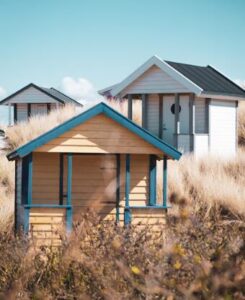
Container site office are inherently sustainable, offering eco-friendly solutions that align with the UAE’s environmental goals and global sustainability trends. Their design and construction minimize environmental impact while maintaining functionality and durability.
Repurposed Materials
Many container offices are made from repurposed shipping containers, which are abundant in the UAE due to its role as a logistics hub. Repurposing containers reduces the demand for new materials, conserves resources, and prevents waste from discarded containers. The steel used in these units is recyclable, ensuring that the office can be repurposed or recycled at the end of its lifespan, contributing to a circular economy.
Reduced Construction Waste
Traditional construction generates significant waste through excess materials, packaging, and demolition debris. Container offices, being prefabricated, produce minimal waste during manufacturing and installation. Components are built with precision in controlled factory environments, reducing errors and excess material use. The modular assembly process further minimizes on-site debris, making it an environmentally responsible choice.
Energy Efficiency
Container offices can incorporate energy-efficient features to reduce consumption:
- Thermal Insulation: Polyurethane foam, rockwool, or polystyrene panels minimize heat transfer, reducing the need for constant air conditioning in the UAE’s hot climate.
- Lighting: LED systems consume up to 80% less energy than traditional lighting, lowering operational costs and environmental impact.
- Solar Integration: Solar panels can power lighting, HVAC, or electronics, leveraging the UAE’s abundant sunlight (over 3,500 hours annually). Battery storage systems ensure a consistent power supply.
- Smart Systems: IoT-enabled climate control and lighting adjust settings based on occupancy or time of day, optimizing energy use.
Water Conservation
For self-contained units with plumbing, water-saving fixtures like low-flow faucets and dual-flush toilets reduce consumption. Greywater recycling systems can be integrated for sustainable water management, particularly in remote areas with limited access to utilities.
Alignment with UAE Sustainability Goals
The UAE’s Vision 2021, UAE Net Zero 2050, and Dubai Clean Energy Strategy 2050 emphasize reducing carbon emissions and promoting green construction. Container offices support these goals by:
- Minimizing construction-related emissions through prefabrication.
- Using recyclable and sustainable materials.
- Reducing land use compared to sprawling traditional buildings.
- Enabling modular designs that adapt to project needs without permanent environmental disruption.
Long-Term Environmental Benefits
The durability of container offices (20–30 years with proper maintenance) reduces the need for frequent replacements, lowering their environmental footprint. Their portability allows reuse across multiple projects, maximizing resource efficiency. Additionally, the ability to retrofit units with new technologies, such as advanced insulation or renewable energy systems, ensures ongoing sustainability.
Biodiversity Considerations
In the UAE, where construction can impact fragile desert ecosystems, container offices minimize land disturbance due to their compact footprint and minimal foundation requirements. Green roofs with native vegetation can further support local biodiversity, providing habitats for small species and reducing urban heat island effects.
Case Studies and Success Stories
Real-world applications of container site office in the UAE demonstrate their versatility, durability, and effectiveness across industries. The following hypothetical but realistic scenarios highlight their practical benefits.
Construction Site in Dubai
A major infrastructure project in Dubai required a temporary office for a team of 20 project managers, engineers, and administrative staff. A 40ft container office was installed near the site, customized with:
- Air conditioning and thermal insulation to combat 50°C summer heat.
- Large shatterproof windows for visibility of construction activities.
- Partitions creating private offices, a meeting room, and a storage area for blueprints and safety gear.
The office’s steel construction withstood daily dust exposure and vibrations from heavy machinery. Its portability allowed relocation to a second site after the initial phase, saving resources and ensuring continuity. The rapid setup (completed in two days) kept the project on schedule, and the sustainable design aligned with the project’s environmental goals.
Oil and Gas Facility in Abu Dhabi
In a remote desert oil field, a 20ft container office served as a supervisory hub for drilling operations. The unit was equipped with:
- Heavy-duty insulation and dehumidifiers to handle extreme temperatures and occasional sandstorms.
- A self-contained restroom and water storage for crew convenience.
- Satellite communication systems for real-time data transmission.
The office’s corrosion-resistant coatings protected against sand abrasion, and its modular design allowed for easy relocation as drilling sites shifted. The self-contained setup provided a comfortable workspace for supervisors working 12-hour shifts, enhancing operational efficiency.
Event Management at a Sharjah Festival
A cultural festival in Sharjah required temporary offices for organizers managing ticketing, vendor coordination, and logistics. A modular complex of three 20ft container offices was deployed, featuring:
- Open-plan layouts with workstations and high-speed Wi-Fi.
- Branded exterior wraps reflecting the festival’s theme.
- Smart lighting and climate control for energy efficiency.
The offices were dismantled and reused at another event, showcasing their flexibility and sustainability. The rapid deployment (completed in one day) ensured organizers could focus on event planning without delays.
SME Startup in a Ras Al Khaimah Free Zone
A tech startup in Ras Al Khaimah used a 10ft container office as a cost-effective base for its five-person team. The unit was customized with:
- Modern furnishings, including ergonomic chairs and built-in desks.
- Large windows and LED lighting for a bright, professional environment.
- High-speed internet and data cabling for software development.
The compact design and low maintenance made it ideal for a startup with limited resources, allowing the team to establish a presence without committing to a long-term lease. The office’s aesthetic finishes aligned with the UAE’s modern business culture.
Community Project in Fujairah
A rural community project in Fujairah used a container office as a temporary training center for vocational workshops. The unit featured:
- An open layout with seating for 15 trainees.
- Solar panels and battery storage for off-grid power.
- Ventilation systems to ensure comfort in humid coastal conditions.
The office’s portability allowed it to be relocated to other communities, supporting ongoing educational initiatives with minimal environmental impact.
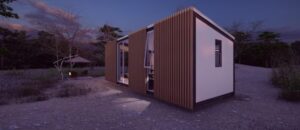
UAE Regulations and Compliance
Container site offices in the UAE must comply with local regulations to ensure safety, structural integrity, and environmental responsibility. Understanding these requirements is critical for successful deployment.
Building Codes
The Dubai Municipality, Abu Dhabi Municipality, and other emirate-specific authorities enforce building codes for temporary and modular structures:
- Structural Integrity: Containers must withstand wind loads (up to 120 km/h in some regions) and seismic activity, requiring robust frameworks and anchoring systems.
- Fire Safety: Fire-resistant materials (e.g., rockwool insulation), smoke detectors, fire extinguishers, and clearly marked emergency exits are mandatory.
- Electrical Systems: Wiring, sockets, and appliances must comply with UAE electrical codes (e.g., DEWA standards in Dubai), ensuring safe power distribution.
- Accessibility: Ramps, wide doorways (minimum 90 cm), and non-slip flooring ensure compliance with UAE accessibility regulations for inclusive use.
Environmental Regulations
The UAE’s environmental policies, aligned with federal and emirate-level sustainability goals, impose requirements on modular structures:
- Waste Management: Installation processes must minimize debris, with recycling plans for packaging or excess materials.
- Energy Efficiency: Offices must incorporate energy-saving features, such as insulation or LED lighting, to reduce consumption.
- Environmental Impact Assessments: For large or permanent setups, assessments may be required to evaluate land use and ecological impact.
Permitting Process
- Temporary Structures: Short-term projects (e.g., construction sites or events) require streamlined permits, typically processed within days by local municipalities.
- Permanent Installations: Long-term or multi-unit setups may need additional approvals, including structural and environmental certifications.
- Zoning Compliance: Urban sites must adhere to zoning laws, while remote sites may require land use permits from local authorities.
Safety Standards
- Ventilation and HVAC: Systems must ensure adequate air quality and temperature control, particularly in the summer months.
- Health and Safety: Occupational health standards require safe working conditions, including proper lighting, ergonomics, and emergency preparedness.
- Inspections: Regular inspections by municipal authorities ensure ongoing compliance, with checklists for structural, electrical, and fire safety.
Best Practices
- Consult with local engineers or contractors familiar with UAE building codes.
- Obtain permits early to avoid delays in installation.
- Use certified materials and systems to streamline compliance processes.
Logistics and Transportation in the UAE
The UAE’s advanced logistics infrastructure supports the efficient delivery and relocation of container site offices, making them a practical choice for businesses across the country.
Transportation Methods
- Tilt Tray Trucks: Used for transporting fully assembled containers to accessible sites, such as urban construction areas or port facilities.
- Hiab Cranes: Ideal for placing containers in tight spaces or elevated locations, common in crowded urban environments.
- Flat-Pack Shipping: Disassembled units reduce shipping volume, lowering costs for remote or international transport. Flat-pack designs are reassembled on-site with minimal effort.
- Container Ships: For large-scale projects, containers can be imported via ports like Jebel Ali, leveraging the UAE’s role as a logistics hub.
Logistics Infrastructure
The UAE’s ports, particularly Jebel Ali, are among the world’s busiest, facilitating the import and distribution of containers. The country’s road network, including highways like Sheikh Zayed Road and E11, ensures efficient transport to urban and rural sites. Logistics providers use GPS tracking, real-time scheduling, and automated fleet management to optimize delivery routes, minimizing delays.
Challenges
- Desert Terrain: Sandy or rocky ground requires specialized vehicles, such as off-road trucks, and robust site preparation to ensure stability.
- Urban Congestion: Traffic in cities like Dubai or Abu Dhabi can delay deliveries, requiring strategic timing (e.g., off-peak hours).
- Remote Locations: Long distances to desert or coastal sites increase transport time and complexity, necessitating experienced logistics partners.
Best Practices
- Partner with logistics providers familiar with UAE terrain and regulations.
- Use flat-pack designs for remote sites to reduce shipping costs.
- Schedule deliveries to avoid peak traffic or extreme weather conditions.
- Conduct pre-delivery site assessments to ensure accessibility and stability.
Maintenance and Durability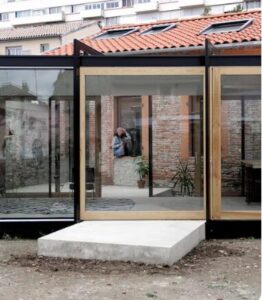
Container site office are designed for long-term durability, but proper maintenance is essential to ensure performance in the UAE’s challenging environment.
Maintenance Requirements
- Exterior Cleaning: Regular washing (every 3–6 months) removes sand, dust, and debris to prevent abrasion and maintain aesthetics.
- Rust Prevention: Apply anti-corrosion coatings every 2–3 years, especially in coastal areas with high humidity and salt exposure.
- HVAC Servicing: Clean and inspect air conditioning units annually to ensure efficiency and prevent breakdowns in extreme heat.
- Structural Checks: Inspect welds, seals, and foundations for wear, particularly after sandstorms or heavy use. Address cracks or damage promptly to prevent escalation.
- Interior Upkeep: Clean furnishings, replace worn components (e.g., flooring), and check electrical systems for safety.
Durability Features
- Materials: Mild steel and galvanized iron resist corrosion, structural fatigue, and environmental stress. Aluminum components reduce weight without sacrificing strength.
- Coatings: Weather-resistant paints and zinc coatings protect against UV radiation, heat, and sand abrasion.
- Design: Sealed joints, reinforced frames, and weatherproof seals prevent water or dust ingress, critical in the UAE’s desert and coastal conditions.
Lifespan
With proper maintenance, container offices can last 20–30 years, making them a durable investment for long-term projects. Their robust construction ensures they withstand the UAE’s extreme temperatures, occasional heavy rains, and sandstorms.
Maintenance Tips
- Schedule regular inspections to identify issues early.
- Use high-quality cleaning products to avoid damaging coatings.
- Train staff on basic upkeep to reduce reliance on external contractors.
- Retrofit units with new technologies (e.g., advanced insulation) to extend lifespan.
Smart Technology Integration
The integration of smart technologies enhances the functionality, efficiency, and user experience of container site office, aligning with the UAE’s focus on innovation and smart infrastructure.
Smart Features
- Climate Control: IoT-enabled thermostats adjust cooling and heating based on occupancy, weather, or time of day, reducing energy consumption by up to 30%.
- Lighting: Smart LED systems with motion sensors or daylight harvesting dim or brighten based on natural light levels, optimizing energy use.
- Security: CCTV cameras, smart locks, and motion sensors provide real-time monitoring and alerts, accessible via mobile apps or cloud platforms.
- Connectivity: High-speed Wi-Fi, Ethernet ports, or satellite systems ensure seamless communication, critical for remote sites or data-intensive operations.
- Energy Monitoring: Smart meters track power usage, providing insights to optimize efficiency and reduce costs.
Benefits
- Energy Savings: Smart systems reduce power consumption, aligning with sustainability goals and lowering operational costs.
- Remote Management: Cloud-based platforms allow users to monitor and control the office from anywhere, ideal for multi-site projects.
- Enhanced Comfort: Automated climate control and lighting ensure a consistent, comfortable environment, boosting productivity.
- Security: Real-time alerts and surveillance deter theft or unauthorized access, critical for high-value equipment or remote locations.
UAE Context
The UAE’s investment in 5G networks, IoT infrastructure, and smart cities (e.g., Dubai’s Smart Dubai initiative) supports the adoption of these technologies. Container offices equipped with smart systems are increasingly used in innovation-driven sectors like construction, logistics, and events, where efficiency and connectivity are paramount.
Implementation Considerations
- Ensure compatibility with UAE’s electrical and data standards.
- Use weather-resistant smart devices to withstand heat and dust.
- Train staff on system operation to maximize benefits.
Comparison with Traditional Offices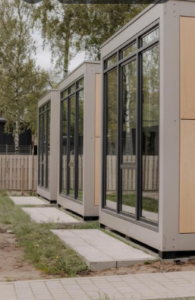
Container site office offer distinct advantages over traditional brick-and-mortar offices, particularly in the UAE’s dynamic environment, but they also have unique considerations.
Cost and Time Efficiency
- Construction Time: Container offices can be deployed in hours or days, compared to months or years for traditional buildings, which require extensive planning, permitting, and construction.
- Resource Use: Prefabrication reduces material and labor costs, while traditional offices involve higher investments in concrete, steel, and on-site labor.
- Maintenance: Container offices require minimal upkeep (e.g., rust prevention, HVAC servicing), whereas traditional buildings need regular repairs for roofing, plumbing, and structural issues.
Flexibility and Scalability
- Portability: Container offices can be relocated or reconfigured, ideal for dynamic projects. Traditional offices are fixed, requiring new construction for relocation.
- Modularity: Containers can be combined or stacked to expand capacity, whereas traditional buildings require costly renovations for expansion.
- Temporary Use: Container offices are perfect for short-term projects, while traditional offices are designed for long-term occupancy.
Sustainability
- Materials: Container offices use recycled or recyclable materials, reducing environmental impact. Traditional construction relies on resource-intensive materials like concrete.
- Waste: Prefabrication minimizes construction debris, while traditional builds generate significant waste.
- Energy Efficiency: Container offices can incorporate insulation, solar panels, and smart systems, whereas older traditional buildings may require retrofitting for efficiency.
Aesthetic and Functional Considerations
- Aesthetics: Container offices can be customized with modern finishes to align with the UAE’s architectural style, but some businesses may prefer the prestige of traditional buildings.
- Space: Containers have fixed dimensions (8–10ft wide), which may limit large teams, whereas traditional offices offer greater flexibility for expansive layouts.
UAE Context
Container offices are ideal for the UAE’s fast-paced, project-driven economy, where rapid deployment and sustainability are priorities. Traditional offices may suit permanent corporate headquarters but are less practical for temporary or remote projects.
Financing and Payment Options
Container site office offer flexible financing and payment options to suit various business needs, making them accessible for projects of all sizes in the UAE.
Ownership Models
- Purchase: Outright ownership is ideal for long-term projects, providing a permanent asset that can be reused across multiple sites.
- Rental: Short-term leases suit temporary needs, such as events or construction phases, allowing businesses to avoid long-term commitments.
- Lease-to-Own: Gradual payments leading to ownership are suitable for businesses with budget constraints, offering flexibility without immediate full investment.
- Bulk Procurement: Ordering multiple units for large projects may streamline logistics and reduce per-unit costs.
Financing Support
The UAE’s banking sector supports financing for modular structures, with options like:
- Business Loans: Tailored loans for purchasing or leasing container offices, with terms aligned to project timelines.
- Islamic Finance: Sharia-compliant financing options, such as Murabaha or Ijara, are available for businesses adhering to Islamic banking principles.
- Supplier Financing: Some suppliers offer in-house payment plans, allowing deferred payments or installment schedules.
Considerations
- Project Duration: Short-term projects benefit from rentals, while long-term projects may justify purchases.
- Customization Needs: Extensive customizations (e.g., smart technology, plumbing) may require higher upfront investment but enhance long-term value.
- Logistics Costs: Delivery and installation costs should be factored into financing plans, particularly for remote sites.
Best Practices
- Compare financing options from multiple banks or suppliers to secure favorable terms.
- Align payment schedules with project cash flows to minimize financial strain.
- Ensure contracts include clear terms for maintenance, warranties, and relocation support.
Design Trends and Aesthetics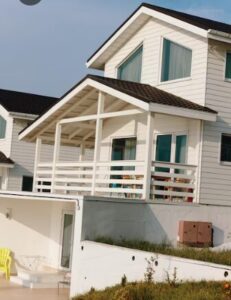
Container site office are evolving beyond their industrial origins to incorporate modern design trends that align with the UAE’s aesthetic and functional preferences.
Current Design Trends
- Large Windows: Floor-to-ceiling shatterproof windows maximize natural light, creating bright, inviting interiors suitable for professional environments.
- Open Layouts: Flexible, open-plan designs support collaborative work, ideal for creative teams or project management hubs.
- Green Roofs: Vegetation or solar panels on roofs enhance sustainability, reduce heat absorption, and add visual appeal.
- Minimalist Finishes: Sleek, clean lines with neutral colors align with the UAE’s modern architectural style, seen in landmarks like Burj Khalifa.
- Modular Complexes: Combining multiple units with connecting walkways or atriums creates expansive, visually striking office setups.
Aesthetic Options
- Industrial Look: Exposed steel and functional designs suit construction or logistics sites, emphasizing durability and simplicity.
- Luxury Finishes: Wood or aluminum cladding, glass facades, or decorative wraps create a premium look for urban or event settings.
- Cultural Elements: Patterns or colors inspired by Emirati heritage (e.g., geometric designs, desert tones) resonate with local audiences.
- Branding: Custom wraps or logos align the office with a company’s identity, ideal for events or corporate projects.
UAE Context
The UAE’s preference for modern, innovative architecture drives demand for aesthetically pleasing container offices. In urban areas like Dubai, sleek designs complement the city’s skyline, while in rural or cultural settings, designs can incorporate traditional elements. The focus on sustainability also encourages eco-friendly aesthetics, such as green roofs or solar-integrated designs.
Functional Design
- Ergonomics: Adjustable desks, ergonomic chairs, and proper lighting enhance user comfort and productivity.
- Space Optimization: Built-in storage, foldable furniture, and multi-purpose layouts maximize limited space.
- Accessibility: Wide doorways, ramps, and barrier-free interiors ensure inclusivity.
Safety and Security Features
Safety and security are paramount for container site office in the UAE, given the diverse environments in which they are deployed.
Safety Features
- Fire Resistance: Fireproof insulation (e.g., rockwool), fire-rated doors, and smoke detectors comply with UAE fire safety codes. Fire extinguishers and sprinkler systems are standard for high-risk areas.
- Ventilation: Mechanical ventilation systems or louvered windows ensure air quality, preventing heat-related illnesses in summer.
- Structural Safety: Reinforced frames and anchoring systems withstand wind, seismic activity, and heavy loads, critical for remote or coastal sites.
- Emergency Preparedness: Clearly marked exits, emergency lighting, and first-aid kits ensure occupant safety during crises.
Security Features
- Reinforced Doors: Steel doors with multi-point locking systems or smart locks prevent unauthorized access.
- Shatterproof Windows: Laminated or tempered glass resists breakage, protecting against theft or vandalism.
- Surveillance: CCTV cameras, motion sensors, and cloud-based monitoring systems provide real-time security, accessible via mobile devices.
- Access Control: Keycard or biometric systems restrict entry to authorized personnel, ideal for sensitive operations.
UAE Considerations
- Coastal Areas: Corrosion-resistant locks and coatings protect against salt exposure in places like Fujairah or Dubai.
- Construction Sites: Robust security deters theft of equipment or materials, common in high-traffic project areas.
- Remote Locations: Satellite-connected surveillance ensures monitoring in areas with limited connectivity.
Best Practices
- Install redundant security systems (e.g., backup cameras, manual locks) for reliability.
- Conduct regular safety drills to prepare staff for emergencies.
- Use certified materials and systems to meet UAE regulations.
Challenges and Limitations
While container site office offer numerous benefits, they also face challenges that businesses must address to ensure successful deployment.
Space Constraints
- Fixed Dimensions: Containers are typically 8–10ft wide, which may limit space for large teams or extensive equipment. Stacking or combining units can mitigate this but increases complexity.
- Solution: Use modular designs to create larger complexes or opt for high-cube containers for additional vertical space.
Climate Adaptation
- Heat and Humidity: The UAE’s extreme temperatures and coastal humidity require advanced insulation, HVAC systems, and dehumidifiers to maintain comfort.
- Solution: Prioritize high-quality insulation (e.g., polyurethane foam) and robust climate control systems.
Aesthetic Perceptions
- Industrial Image: The utilitarian look of containers may not appeal to businesses seeking a prestigious or traditional office appearance.
- Solution: Use premium finishes, such as glass facades or decorative cladding, to align with modern aesthetics.
Regulatory Hurdles
- Permitting: Urban areas require strict compliance with zoning and building codes, which can delay installation. Remote sites may need environmental assessments.
- Solution: Work with local consultants to navigate permitting processes early.
Transport Challenges
- Remote Access: Desert or mountainous terrain can complicate delivery, requiring specialized vehicles or site preparation.
- Solution: Use flat-pack designs or coordinate with experienced logistics providers.
Noise and Privacy
- Noise: Construction sites or urban areas can be noisy, requiring soundproofing to ensure a productive environment.
- Solution: Use high-density insulation and sealed designs to reduce noise levels below 30 decibels.
- Privacy: Open layouts may not suit businesses requiring discreet operations.
- Solution: Add partitions or soundproof meeting rooms for privacy.
Future Innovations in Container Offices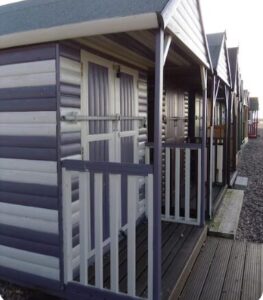
The future of container site office in the UAE is shaped by technological advancements, sustainability trends, and the country’s vision for smart infrastructure.
Emerging Technologies
- 3D Printing: Advanced 3D printing can produce custom container components with minimal waste, enabling bespoke designs and faster production.
- AI and IoT: AI-driven climate control and predictive maintenance systems optimize energy use and detect issues before they escalate.
- Augmented Reality (AR): AR tools allow businesses to visualize and customize container layouts before installation, improving design accuracy.
Sustainability Innovations
- Zero-Waste Designs: Fully recyclable materials and circular construction processes minimize environmental impact.
- Advanced Solar Systems: Next-generation solar panels with higher efficiency and integrated battery storage support off-grid operations.
- Green Building Materials: Biodegradable insulation or eco-friendly coatings reduce the carbon footprint.
Modular Advancements
- Self-Sustaining Units: Containers with integrated water recycling, solar power, and waste management systems for complete autonomy in remote areas.
- Scalable Complexes: Automated assembly systems enable rapid construction of multi-unit office complexes for large projects.
UAE Context
The UAE’s investment in smart cities, such as Dubai’s Sustainable City, and its focus on innovation (e.g., Dubai Future Foundation) drive the adoption of these technologies. Container offices equipped with advanced features will play a key role in supporting the country’s ambitious development goals.
Container Office Rental Market in the UAE
The rental market for container offices in the UAE is robust, driven by demand for temporary workspaces in dynamic industries.
Use Cases
- Construction Projects: Short-term offices for site management, dismantled after project completion.
- Events and Festivals: Temporary hubs for ticketing, logistics, or staff facilities during expos or cultural events.
- Seasonal Operations: Workspaces for seasonal trade surges, such as holiday logistics or tourism-related projects.
- Emergency Response: Rapidly deployed offices for disaster relief or temporary community services.
Benefits
- Flexibility: Rentals allow businesses to scale workspaces without long-term commitments.
- Cost Efficiency: Avoids the upfront investment of purchasing, ideal for short-term needs.
- Rapid Deployment: Units are delivered ready for use, minimizing downtime.
Considerations
- Rental Terms: Contracts should specify duration, maintenance responsibilities, and relocation options.
- Customization: Rental units may have limited customization compared to purchased units, so businesses should clarify available features.
- Logistics: Ensure suppliers can deliver to the project site, particularly in remote areas.
UAE Context
The UAE’s event-driven economy (e.g., Dubai Expo, cultural festivals) and construction boom create a strong rental market for container offices. The country’s logistics infrastructure supports efficient delivery and setup, making rentals a practical choice.
Cultural and Business Considerations in the UAE
Container offices must align with the UAE’s cultural and business norms to ensure acceptance and functionality.
Cultural Alignment
- Privacy: Emirati culture values discretion, so offices should include private meeting rooms or partitions for confidential discussions.
- Hospitality: Spaces for serving refreshments or hosting clients reflect the UAE’s emphasis on hospitality in business settings.
- Aesthetic Sensitivity: Designs incorporating local patterns, colors (e.g., desert tones), or modern finishes resonate with cultural preferences.
Business Considerations
- Professionalism: Sleek, modern designs align with the UAE’s image as a global business hub, appealing to clients and partners.
- Efficiency: Rapid deployment and flexible layouts support the fast-paced nature of UAE projects.
- Sustainability: Eco-friendly designs align with corporate social responsibility goals, appealing to businesses with environmental priorities.
Practical Applications
- Client Meetings: Dedicated meeting rooms with high-quality furnishings for professional interactions.
- Team Collaboration: Open-plan layouts foster teamwork, which is common in the UAE’s innovative industries.
- Cultural Events: Branded or themed offices for festivals or expos reflect local heritage and enhance engagement.
Environmental Adaptability in the UAE
Container offices are designed to perform in the UAE’s diverse and challenging climates, ensuring functionality and comfort.
Heat Resistance
- Insulation: Polyurethane foam or rockwool panels reduce heat transfer, maintaining interior temperatures 20–30°C cooler than outside.
- Reflective Coatings: White or reflective paints on exteriors deflect solar radiation, reducing cooling needs.
- Air Conditioning: High-efficiency units with VRF technology ensure precise temperature control.
Sandstorm Protection
- Sealed Designs: Weatherproof seals and gaskets prevent dust ingress, protecting electronics and furnishings.
- Durable Materials: Galvanized iron and corrosion-resistant coatings withstand sand abrasion.
- Filtration Systems: Advanced HVAC filters remove dust particles, maintaining air quality.
Coastal Humidity
- Anti-Corrosion Coatings: Zinc or epoxy coatings protect against salt-induced rust in areas like Dubai or Fujairah.
- Dehumidifiers: Integrated systems prevent moisture damage to interiors and equipment.
- Ventilation: Mechanical or natural ventilation systems reduce humidity buildup.
Seasonal Variations
- Rainfall: Rare but heavy rains require proper drainage and waterproofing to prevent flooding.
- Temperature Fluctuations: Insulation and dual-mode HVAC systems handle summer heat and winter cooling needs.
Supplier Selection Guide
Choosing a supplier for container site office involves evaluating several factors to ensure quality, functionality, and compliance with UAE standards.
Key Criteria
- Quality: Verify the use of durable materials (e.g., mild steel, galvanized iron) and compliance with international standards (ISO, DNV-GL).
- Customization: Ensure suppliers offer flexible design options, such as layouts, climate control, and technology integration.
- Experience: Choose providers with expertise in UAE projects, familiar with local climate and regulations.
- Logistics: Confirm efficient delivery and installation capabilities, particularly for remote or urban sites.
- Support: Look for robust after-sales services, including maintenance, warranties, and relocation assistance.
Questions to Ask
- What materials and standards are used in construction?
- What customization options are available for specific industries?
- How do you ensure compliance with UAE building and environmental codes?
- What are the delivery timelines and logistics capabilities?
- What support is provided for maintenance or relocation?
Best Practices
- Request detailed proposals with technical specifications and timelines.
- Verify supplier certifications and past project experience in the UAE.
- Conduct site visits to assess sample units for quality and functionality.
- Ensure contracts include clear terms for warranties and support.
Conclusion
Container site office are a transformative solution for the UAE’s dynamic industries, offering portability, durability, sustainability, and customization. Their ability to adapt to the country’s extreme climate, rapid project timelines, and environmental goals makes them ideal for construction, oil and gas, logistics, events, SMEs, and community projects. From their eco-friendly design to their integration of smart technologies, container offices exemplify the future of flexible and efficient workspaces in the UAE.
This guide has explored every facet of container site office, from their technical specifications and industry applications to their regulatory compliance and future innovations. By addressing practical considerations, such as installation, maintenance, and cultural alignment, it provides a comprehensive resource for businesses seeking to leverage these innovative solutions.
Call-to-Action: Discover the potential of a container site office for your next project in the UAE. Contact suppliers to explore customization options, discuss your specific needs, and find the ideal workspace solution tailored to your industry.
Frequently Asked Questions
What is a container site office?
A portable, prefabricated workspace made from shipping containers or steel, designed for temporary or semi-permanent use in industries like construction, logistics, or events.
How are container offices adapted for the UAE’s climate?
They feature advanced insulation (e.g., polyurethane foam), high-efficiency air conditioning, dehumidifiers, and corrosion-resistant coatings to handle heat, sandstorms, and humidity.
What industries use container offices in the UAE?
Construction, oil and gas, logistics, events, SMEs, and community projects benefit from their portability, durability, and customization.
Can container offices be customized?
Yes, with options for interior layouts, windows, doors, HVAC, plumbing, furnishings, and smart technology to meet specific needs.
How do container offices align with UAE sustainability goals?
They use recycled materials, produce minimal waste, and incorporate energy-efficient features like insulation, LED lighting, and solar panels.
How are container offices installed?
The process involves site assessment, preparation, delivery, assembly, utility connections, and final inspection, tailored to the UAE’s terrain and regulations.
What are the maintenance requirements?
Regular cleaning, rust prevention, HVAC servicing, and structural checks ensure longevity, with minimal upkeep compared to traditional buildings.
Are container offices secure?
Yes, with reinforced doors, shatterproof windows, CCTV, and smart locks to protect occupants and equipment.
